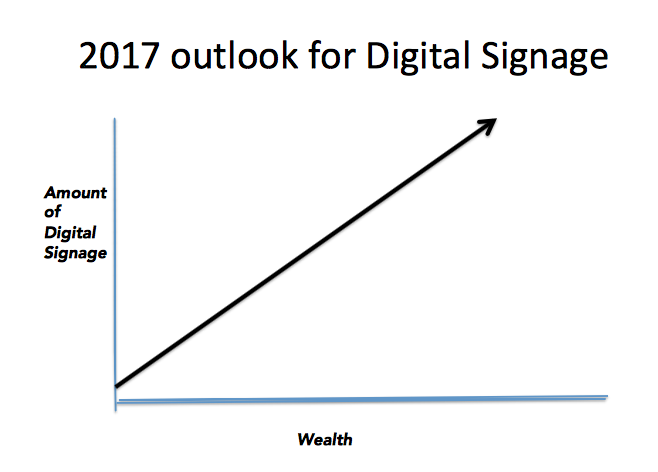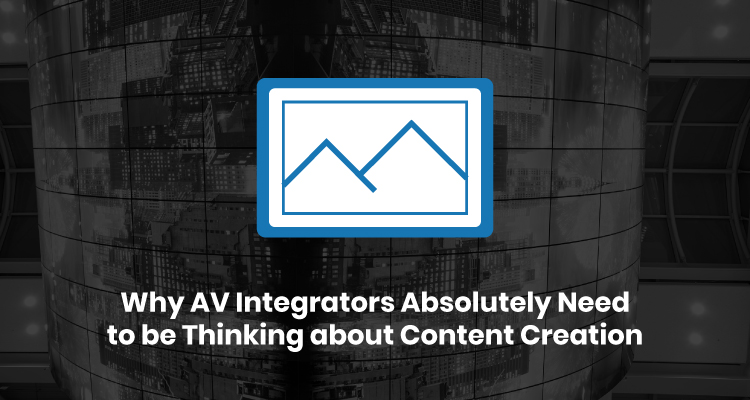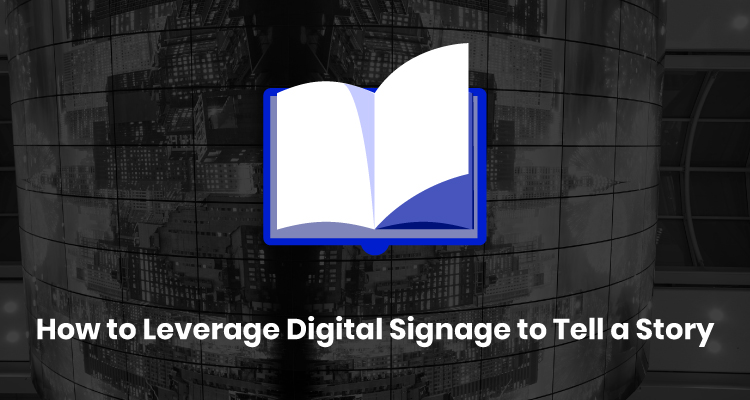The Outlook for Digital Signage in 2017 Is More, More, More
 Yogi Berra wasn’t referencing digital signage when he said, “It’s very tough to make predictions, especially about the future.” Digital signage and place-based media can apply present status, and, with a wide enough view of the lens and clarity into the depth, know what is coming in 2017.
Yogi Berra wasn’t referencing digital signage when he said, “It’s very tough to make predictions, especially about the future.” Digital signage and place-based media can apply present status, and, with a wide enough view of the lens and clarity into the depth, know what is coming in 2017.
The proposition is simple. More digital signage equals more wealth – for end users that apply it, and the suppliers that provide it.
2017 will be characterized by “more.” But it is the life cycles of application and supply that will factor most significantly into the outlook for this media sector in 2017.
 The outlook is threefold for end users In the year of the enabled consumer and omni-channel as both drive forward unabated. Firms that have used the media and assess its impact will increase their use, led by gap analysis and growth planning. In realizing its investment worthiness early adopters will drive innovations in content strategy, tactic and composition, viewer targeting and day parting as well as operating efficiencies. Current users will drive significant industry investment as they expand their use. The best of suppliers will benefit most.
The outlook is threefold for end users In the year of the enabled consumer and omni-channel as both drive forward unabated. Firms that have used the media and assess its impact will increase their use, led by gap analysis and growth planning. In realizing its investment worthiness early adopters will drive innovations in content strategy, tactic and composition, viewer targeting and day parting as well as operating efficiencies. Current users will drive significant industry investment as they expand their use. The best of suppliers will benefit most.
New users tend toward simple solutions as they minimize investment and risk in putting their foot in the water. Integrators and small suppliers will benefit most from new users.
The majority of users in the middle of the bell curve with new users at one end and the most experienced at the other will add employee hours to their operations as the medium finds a growing place within their enterprise. These will drive education and publication consumption to much higher levels.
- More innovations will be driven by experienced end users seeking more business value.
- More new deployments will be driven by the later majority of end users based on their confidence through seeing their competitors apply it.
- More investment will be made as virtually all current end users seek to expand their benefits through incremental improvements.
Measurement, (the basis of investment decisions and approaches) has been pregnant with the gestation period of an elephant, though some can rightly say the analogy is closer to that of an acorn. (There is an oak tree in there, but all the conditions have to be right for even a sprout to appear beneath the light of day).
Digital signage has too often been considered in a fairly narrow range of benefits and the lack of tangible impact and attribution data that can validate increased investment has been the failing of end users and operators.
Analytics capability typically has required more effort than brains, so has not distinguished itself in operations. But “content” as the sibling of analytics, requires brains and optimizing content requires analytics if it is to be treated as anything beyond craft and artistry into the science that it is.
Content delivers the value of digital signage once the technology is in place. The technology wants to, and will deliver more messaging productivity with more compelling images and more efficiency in 2017.
Content will be a significant growth area in 2017 as it contributes higher return on investment and validates technology investment. No end user wants digital signage. What they do want is greater efficiency in messaging and engagement impact.
- More content strategy, tactics, audience targeting, day parting will mean significantly more content and innovation in composition.
- More analytics and impact assessment will be used to drive content ROI.
Starbucks, for example recently debuted a cartoon web series titled 1st and Main that has implications for on-location digital signage. In the overlap with “owned” media, brands that have established their social media channels are well positioned to take short-form story-telling content into their physical locations.
The retail infotainment media channel has too many branding possibilities to be overlooked. There is a reason that many retailers have put their online social media channels in place with many taking the early steps with in-store digital media. People love stories and animated content can deliver a moment of joy, add character to a brand, build aspirations, inform and entertain while adding ambiance and vitality to the brand. Reducing perceived waiting and dwell times are the icing on the branding and merchandising cakes. Marketing meets selling with in-store media.
Key markets for 2017 include retail, food services, financial services, hospitality, health care, education and staff communications.
More digital signage in physical retail locations will help retail and other customer-facing brands to move to a new level of location appeal, branding and merchandising. Digital signage will help drive online and mobile success.
Share of wallet for food spending and information about food (e.g., calories, nutritional value, allergens, ingredients, sources) will continue to drive digital signage investment. Order accuracy is a high priority for quick service and fast casual restaurants, and service times have been declining against the backdrop of consumer preference and greater consumer choice.
Financial services must capture the millennials demographic as a primary long- term growth market while increasing the number of products per customer. Insurance, securities, wealth management and accounting service are compelled to innovation in their marketing models in order to compete.
Hospitality as a services industry must increasingly tap into the “experience economy” by making their locations the destination of choice while attracting engagement with onsite amenities and on-premises services.
Health care providers that move beyond outdated magazines and TV in their waiting rooms toward health improvement information and onsite education will enjoy greater branding, consumer selection, revenues and donations.
More architectural media will be added to increase the attraction to physical locations and enable better customer and staff engagement. Advances in OLED production by firms such as LG Electronics provide dramatic improvements in media appeal and the ability to integrate new generation displays into an environment. The capacity of OLED to present High Dynamic Range (HDR) content further enables media presentation.
Integrators of audio/visual, information and security technologies stand to benefit greatly as small and medium sized enterprises follow large businesses in digital signage installation. The onus has been on end user to define the benefits that they may receive, but they must have the confidence in technology supply as well as in the knowledge that integrators are bringing deep awareness and insights into how a digital signage investment will support their achievement of business goals. Integrators have not benefited to the extent possible by engaging with digital signage. Knowledge is their key to success. When Integrators simply respond to a technology requirement they can quickly erode their margins and supply positioning, but being part of defining the solution that addresses business problems and opportunities through digital signage puts their capabilities in high demand and is the stable, certain ride to success. Integrators will bring:
- More capability to planning and technology recommendations.
- More demand for education and training to support end users.
More capacity by large turnkey providers will be added. The integration and network operations services of software, connectivity and media services providers will continue to expand fueled in part by acquisitions in 2016 which have gone a long way toward enterprise integration of the medium. Large providers are poised to add double-digit numbers of new staff members their teams.
More supply capability through turnkey supply and tighter supply relationships among individual providers that reflect the village of supply. New providers will integrate the management of multiple media types and technologies.
More effort for industry-wide benefits on the part of industry associations must surely be undertaken in 2017. The challenge of patent trolls has been increasing with patent holders harvesting licensing revenue agreements from suppliers and end users. This industry-wide issue is one that digital signage trade associations can play a coordinating role in addressing.
Digital signage associations and event producers can play a key role in profiling how digital signage and place-based media contribute to location-based and omni-channel marketing. “Digital” has advanced with many silos of initiatives within the enterprise and efforts related to customer experience and big data can fuel application of the medium.
At an uppermost level of consideration no supplier has a unique solution. It is at lower levels that differences, in some cases very big differences, emerge. And every application is unique to the priority of problems solved and opportunities realized. Content strategy and tactics enabled by technology infrastructure will increasingly define the return on investment. As It is imperative to diversify the brand in the context of omni-channel, more functionality aimed at integrating media devices will be added in 2017.
In 2017, more success will go to end users and providers who work for it, by gaining knowledge and using this for directing their efforts and consensus development. Gap analysis will be the key enabler of digital signage in 2017.
This column was reprinted with permission from Lyle Bunn.




